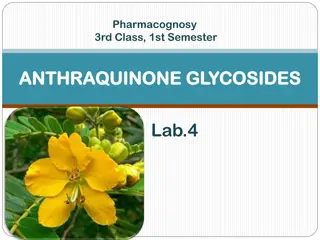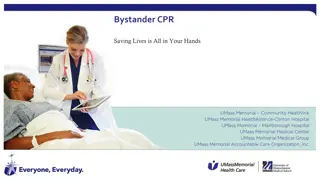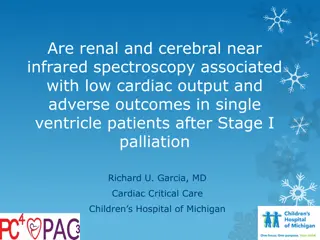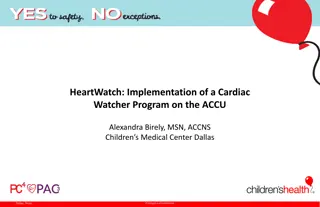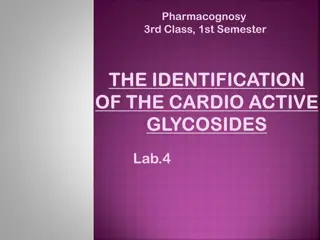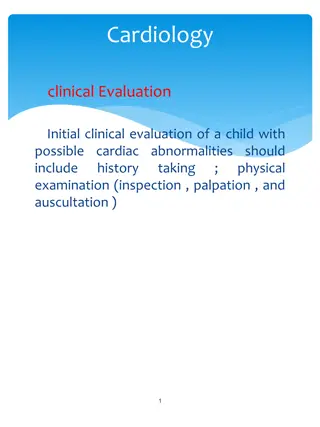Identification of Cardioactive Glycosides in Pharmacognosy Lab Experiments
In this Pharmacognosy lab session, students learn about the identification of cardioactive glycosides through chemical tests like Baljets Test and Keller-Killians Test. These tests involve specific procedures using reagents like picric acid, sodium hydroxide, glacial acetic acid, ferric chloride, an
1 views • 11 slides
Saponin Glycosides in Pharmacognosy: Properties and Applications
Saponin glycosides, found in various plants, are compounds with diverse benefits ranging from cholesterol regulation to potential anticancer properties. They form colloidal solutions in water and are used in soap manufacturing due to their unique properties. Additionally, saponins have bitter taste,
7 views • 18 slides
Anthraquinone Glycosides: Pharmacognosy Insights
Anthraquinone glycosides are compounds found in medicinal plants like Senna, Cascara, and Aloe, known for their therapeutic actions. These glycosides are hydrolyzed to yield active aglycones, which act as stimulant cathartics by increasing smooth muscle tone in the colon. Market formulations and ext
1 views • 11 slides
Bystander CPR: Steps to Save Lives & Facts About Cardiac Arrest
Learn the importance of bystander CPR in saving lives during sudden cardiac arrest incidents. Understand the steps to perform hands-only CPR, identify compression rates, and the role of the Good Samaritan law. Discover key facts about sudden cardiac arrest and how bystander intervention can signific
1 views • 13 slides
ANTHRAQUINONE GLYCOSIDES Lab.4
Anthraquinone glycosides, found in certain plants, exert a stimulant cathartic effect by increasing smooth muscle tone in the colon. Administered orally, these compounds are hydrolyzed in the colon to active forms, providing relief from constipation. Long-term use of stimulant laxatives can lead to
0 views • 11 slides
Acoramidis Improves Cardiac Function in Transthyretin Amyloid Cardiomyopathy
Acoramidis, a next-generation TTR stabilizer, shows promising results in improving cardiac function and promoting regression in Transthyretin Amyloid Cardiomyopathy. The ATTRibute-CM Cardiac Magnetic Resonance Substudy evaluated changes in cardiac structure, function, and amyloid burden after treatm
0 views • 8 slides
Delving into Implant Monitoring Services for Improved Patient Care
Cardiac implantable devices like pacemakers, cardiac loop records, and implantable cardioverter defibrillators require extensive cardiac implant monitoring services to help safeguard the patients' heart health at all times. Let\u2019s get started.\n
6 views • 5 slides
Glycosides: Secondary Metabolites in Pharmacognosy
Glycosides are naturally occurring compounds with sugar and non-sugar components. They are characterized by glycosidic bonds and can be chemically separated. These compounds exhibit various physical and chemical properties, including solubility, taste, and optical activity. Classification based on g
1 views • 11 slides
Anthracene Glycosides in Pharmacognosy and Phytochemistry
Anthracene glycosides are secondary metabolites found in various plant families, offering therapeutic benefits. This comprehensive study explores their composition, chemistry, biosources, and applications, detailing the structural variations of aglycones and sugars present in these compounds. Method
1 views • 30 slides
Cardiac Output and Venous Return in Cardiovascular Physiology
Cardiac output, stroke volume, end-diastolic and end-systolic volumes play vital roles in cardiovascular function. Factors affecting cardiac output include physiological conditions and pathological states like hyperthyroidism and myocardial infarction. Venous return, controlled by mechanisms like Fr
0 views • 27 slides
Association of Renal and Cerebral Near-Infrared Spectroscopy with Adverse Outcomes in Single Ventricle Patients after Stage I Palliation
Study investigates the association between renal and cerebral near-infrared spectroscopy (NIRS) values and low cardiac output syndrome in single ventricle patients post Stage I palliation. Data from infants who underwent surgery between 2010-2019 is analyzed to determine correlations with adverse ou
1 views • 13 slides
Pharmacognosy and Phytochemistry II: Secondary Metabolites and Their Therapeutic Applications
This unit delves into the composition, chemistry, therapeutic uses, and commercial applications of secondary metabolites such as steroids, cardiac glycosides, and triterpenoids. It explores the properties of saponin glycosides, their classification based on aglycone nature, and the significance of s
0 views • 23 slides
Cardiac Electrical Activity in Physiology Team's Cardiovascular Block Lecture
Dive into the intricate details of cardiac electrical activity in this lecture led by Physiology Team 436. Explore topics like the cardiac conductive system, action potentials, refractory periods, excitation-contraction coupling, and the effects of autonomic stimulation on heart electrophysiology. D
0 views • 29 slides
Implementation of Cardiac Watcher Program in CMC Dallas
Twofold increase in sudden cardiac arrests on the ACCU prompted the implementation of the Cardiac Watcher Program in Children's Medical Center, Dallas. The program aims to decrease cardiac arrests by improving patient identification and creating a shared mental model among team members. Developed pa
0 views • 9 slides
Isolation and Characterization of Glycosides: Glycyrrhetinic acid and Rutin
This study focuses on the isolation and analysis of phytoconstituents, mainly glycosides such as Glycyrrhetinic acid and Rutin. It explains the methods for extracting glycosides, purification techniques, and characterization using spectroscopy methods. The detailed procedures for isolating Glycyrrhe
1 views • 19 slides
Saponin Glycosides in Pharmacognosy: Properties and Applications
Saponin glycosides are plant compounds with diverse applications, from forming colloidal solutions to binding with cholesterol in the body. They possess bitter taste and detergent-like properties, offering benefits in health and industry. Learn about their structures, sources like Quillaia saponaria
4 views • 18 slides
Overview of Secondary Metabolites: Alkaloids, Flavonoids, Steroids, and Glycosides
Exploring the diverse world of secondary metabolites, this content delves into the composition, chemistry, biosources, therapeutic uses, and commercial applications of various compounds such as Alkaloids, Flavonoids, Steroids, Glycosides, and more. It discusses the structural characteristics, biolog
0 views • 17 slides
Cardiac Diseases in Pregnancy: Implications and Management
Normal pregnancy induces significant physiologic changes in the cardiovascular system, which can impact women with pre-existing cardiac diseases. Understanding the New York Heart Association classification scheme is crucial for assessing symptomatology during pregnancy. Rheumatic Heart Disease, part
0 views • 12 slides
Identification of Cardioactive Glycosides Through Chemical Tests
The laboratory experiments focus on identifying cardioactive glycosides through chemical tests like Baljets Test and Keller-Killians Test. These tests involve reactions with specific reagents to observe color changes and layer formations, helping in the identification of different parts of the glyco
3 views • 11 slides
Bystander CPR: Steps to Save Lives During Cardiac Arrest
Learn how to perform hands-only CPR effectively in case of cardiac arrest. Understand the importance of quick action, proper compression rate, and the Good Samaritan law. Discover facts about sudden cardiac arrest and why bystander CPR can significantly increase survival rates. Follow a guide on wha
0 views • 13 slides
Drugs Affecting the Cardiovascular System: Overview and Mechanisms
Explore the impact of various drugs on the cardiovascular system, including cardiac glycosides, vasodilators, anticoagulants, and more. Learn about the chemical nature and properties of glycosides and how they affect the heart's functioning.
1 views • 21 slides
Association of Renal and Cerebral Near Infrared Spectroscopy with Low Cardiac Output in Single Ventricle Patients
Near-infrared spectroscopy (NIRS) has been studied in infants after Stage I palliation surgery to assess its association with low cardiac output and adverse outcomes. This retrospective study investigated postoperative cerebral and renal NIRS values in infants with single ventricle physiology. Resul
0 views • 13 slides
Cardiac Glycosides in Pharmacognosy and Phytochemistry
Explore the role of Steroids, Cardiac Glycosides, and Triterpenoids in pharmacognosy and phytochemistry, focusing on their general introduction, composition, chemistry, biosources, therapeutic uses, and commercial applications. Learn about the structure and attachment of sugar parts in Cardiac Glyco
9 views • 9 slides
Overview of Indole Alkaloids in Pharmacognosy and Phytochemistry II
Indole alkaloids are a significant group of naturally occurring compounds with diverse chemical structures and physiological actions. This unit delves into the general introduction, composition, chemistry, biosources, therapeutic uses, and commercial applications of various secondary metabolites, in
0 views • 17 slides
Pathophysiology of Cardiac Failure and Adaptive Mechanisms of the Heart
Cardiac failure is a condition where the heart is unable to meet tissue metabolic needs despite normal or increased venous return. Causes include decreased contractility, coronary blood flow, damaged valves, and more. Normal resting cardiac output is 5 Lt/mts, with adaptive mechanisms like the Frank
1 views • 35 slides
Cardiac MR Measurements Guide
This guide provides detailed instructions and images on how to measure various parameters in cardiac MR imaging, including left ventricle measurements in diastole and systole, LA measurements, aorta measurements, and EF calculations using CVI42 software. It also includes steps for phase calculations
0 views • 8 slides
Isolation of Cardioactive Glycosides in Pharmacognosy Lab: Procedure and Results
In this pharmacognosy lab experiment, the aim is to isolate cardioactive glycosides from plant material using various equipment and reagents. The procedure involves maceration, extraction, and separation steps to isolate Fraction A containing the whole glycoside. The results indicate successful isol
0 views • 8 slides
Identification of Cardioactive Glycosides in Pharmacognosy Lab Experiments
The lab experiments focus on identifying cardioactive glycosides using chemical tests like Baljets Test and Keller-Killians Test, along with the identification of sterol glycosides through Raymmonds and Kedds reactions. These tests involve specific procedures with different reagents to observe color
0 views • 11 slides
The Importance of Addressing Cardiovascular Disease in Maternal Health
Cardiovascular disease remains a significant contributor to maternal mortality in the UK, with maternal deaths from cardiac issues outnumbering those from other direct causes, except thrombosis. The prevalence of cardiovascular risk factors in pregnant women, combined with a lack of consideration fo
0 views • 22 slides
Canadian Cardiac Transplant Network Status Review 2021
The Canadian Cardiac Transplant Network Status Review 2021 provides a detailed overview of cardiac transplant programs across various provinces in Canada from 2016 to 2021. The report includes data on the number of cases, hospitals involved, and referral centers, showcasing the trends in cardiac tra
1 views • 59 slides
Thrombolytics in Cardiac Arrest from Pulmonary Embolism: Evidence Review
Thrombolytics are suggested for cardiac arrest from presumed PE despite lack of RCTs focusing on this subset. Studies on undifferentiated cardiac arrest did not show a survival benefit. Trials using tissue plasminogen activator in PEA arrest showed no significant difference in outcomes, while a stud
0 views • 13 slides
Secondary Metabolites in Ruta Graveolens for Therapeutic Applications
Delve into the world of secondary metabolites found in Ruta graveolens, commonly known as Rue or Garden Rue. Discover its rich composition of alkaloids, phenylpropanoids, flavonoids, steroids, cardiac glycosides, triterpenoids, volatile oils, tannins, resins, glycosides, iridoids, and other terpenoi
0 views • 13 slides
Comprehensive Clinical Evaluation of Children with Cardiac Abnormalities
Initial clinical evaluation of a child with possible cardiac abnormalities includes history taking and physical examination. History should cover symptoms related to pulmonary and systemic venous congestion, cyanosis, cyanotic spells, palpitations, chest pain, and more. The general physical examinat
0 views • 65 slides
Cardiac Action Potential: Ionic Basis and Excitability in Cells
Explore the complex processes underlying cardiac action potential, from ionic equilibrium to resting membrane potential and excitability in cardiac cells. Learn about the critical thresholds, equilibrium potentials, and gradients that regulate the electrical activity of the heart. Discover the intri
0 views • 68 slides
Cardiotoxic Glycosides in Plants: Toxicity and Mechanism of Action - Overview
Plants like Nerium oleander, Thevetia peruviana contain cardiotoxic glycosides causing toxicity in animals and humans. Poisoning with these plants can be fatal, affecting the heart and nerves. Toxicity is mainly due to compounds like oleandroside and oleandrin, leading to cardiac failure and gastroi
0 views • 13 slides
Loss of Consciousness and Sudden Cardiac Death in Children
Loss of consciousness, including syncope and sudden cardiac death, is a significant concern in pediatric patients. The epidemiology shows that approximately 25% of children experience at least one episode of loss of consciousness before the age of 19, with girls visiting pediatricians more than boys
0 views • 5 slides
Glycosides: Classification, Identification, and Toxicity in Poisonous Plants
Glycosides, ethers with a carbohydrate and non-carbohydrate moiety, are key toxicants in poisonous plants. Cyanogenic glycosides yield hydrocyanic acid, goitrogenic glycosides inhibit thyroid hormone production, while coumarin glycosides can lead to vitamin K deficiency. Steroid and triterpenoid gly
0 views • 25 slides
Glycosides in Pharmacognosy: A Comprehensive Overview
Organic natural compounds known as glycosides are prevalent in plants and organisms, offering diverse therapeutic benefits. This article delves into the definition of glycosides, glycosidic linkages, and different types like O-, S-, N-, and C-glycosides, with examples from nature. The distinction be
0 views • 25 slides
Glycosides: A Comprehensive Overview
Glycosides are compounds that undergo hydrolysis to yield sugar and non-sugar parts. The aglycone is also known as the genin, while the sugar part is the glycone. They are soluble in water and alcohols, with different solubility properties for glycone and aglycone parts. Glycosides can be hydrolyzed
0 views • 12 slides
Emergency Management in Cardiac Intensive Care
Information on managing emergencies in cardiac intensive care including topics like hemorrhage post-cardiac surgery, tamponade post-cardiac surgery, and control of bleeding. Details on initial steps for bleeding control, teamwork in managing hemorrhage, and diagnosing tamponade post-cardiac surgery
0 views • 16 slides


